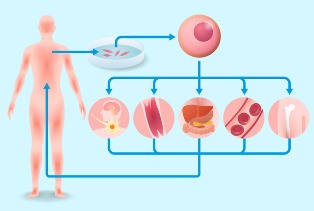
- A human embryonic stem cell (hereafter called "human ES cell")
was established in 1998 by a fertilized egg, and induced pluripotent stem
cells (hereafter called "human iPS cell") was established from
human somatic cell by Professor Yamanaka at Kyoto University iPS Institute
in 2007.
The human ES cell and human iPS cell are stem cells which show the capability
to proliferate to the large number of cells without differentiation. They
also make it possible to differenciate the general any cell type in the
body. The both are pluripotent stem cell to provide a new cell therapy
for diseases.
- 1. Cells required in conventional cell transplantation therapy
Tissue and fibroblast cells in the patient's tissue with large-scale
culture and proliferation are transplanted to local site.
- E.g. Autologous chondrocyte implantation, autologous cultured corneal
cells and myocardial cell sheet expanded by
using myoblast are commercialized.
-
- 2. Stomatic stem cell
As a characteristic of somatic, somatic cell has the self-replication
capability existing at each organ or tissue and the limited differentitation
ability to constituting cell of belonging organ or tissue (Somatic cell
does not show pluripotent).
- E.g. Hematopoietic stem cell
(Indication: leukemia and malignant lymphoma)
Human allogeneic bone marrow-derived mesenchymal stem cell
(Indication: GvHD)
Human neural stem cell
(Indication: Dry age-related mesenchymal stem cell, etc.)
Human adipose tissue-derived mesenchymal stem cell
(Indication: Chronic ischemic cardiomyopathy, etc.)
-
- 3. Pluripotent stem cell
This stem cell has pluripotency to differentiate cell type of whole body
with the unlimited proliferative capability. Realization of cell therapy
to recover the the organ function by transplantation of the specific
cell type, which was obtained by pluripotent stem cell, is planned.
- 3-1) Human ES cell
This stem cell is established by a part of human fertilized egg blastocyst.
It is possible to preserve the undifferentiated state with
maintaining of differentiation potency to cell types. It has the characteristic
to proliferate in the culture system endlessly with holding a
normal gene unlike a cancer cell.
For realization of the regenerative medicine, the differentiation-inducing
development from human ES stem cell to specific cell types and
the establishment of proliferation technology must be in a hurry. In
particular, the chemical biology (differentiation-inducing method like
growth factor and gene recombination, etc.) are regarded as effective
development method.
- E.g. Pancreatic endoblast cell which was provided through the differentiation-inducing
from human ES stem cell line
(Indication: Rebeneration of β-cell)
- 〈Key Technical term〉
Feeder cell, Mechnism to maintain the undifferentiated state,
Differentiation-inducing (growth factor, extracellular matrix,
gene manipulation)
- 3-2) Human iPs cell
Human induced pluripotent stem cells (Nanog-iPS cell) which had pluripotency
as well as a human ES cell was provided by the
introducing of Yamanaka 4 factors into a human fibroblast using the
retrovirus. In addition, human induced pluripotent stem cells are
provided equally by the introducing of 4 different combination factors
(OCT4, SOX2, NANOG, LIN28) into human fibroblast in the
United State (Yu, J. et al. : Science, 318:1917-20, 2007).
- The advantage of human induced pluripotent stem cells is that the establishment
by an autologous somatic cell enabled development of
the transplant therapy without the rejection. In addition, new cell
therapy that iPS cell is established by a patient somatic cell and then
a cause gene is repaired by modification in culture system of the iPS
cell is expected.
- However, the conclusion of the medical study results between human
iPS cells and human ES cell is not provided yet.
- 〔Current development status of human iPS cell〕
GCP clinical trial is not performed yet even though clinical research
is ongoing.
-

- 〈Key Technical Term〉
Somatic cell, cellular repropramming, Yamanaka 4 factors, Cell
fusion, Disease-specific iPS cell, Differentiation-inducing to
specific cell type, iPS cell bank for regenerative medicine, R&D
for cell therapy in combination with a gene therapy
-


